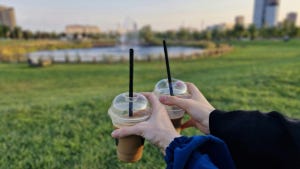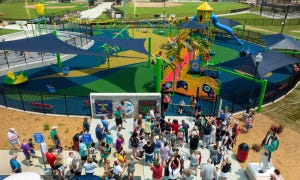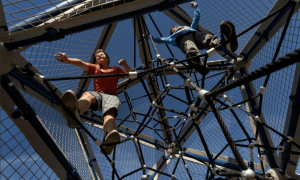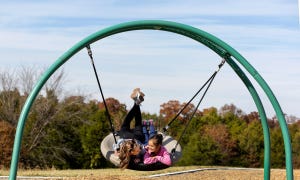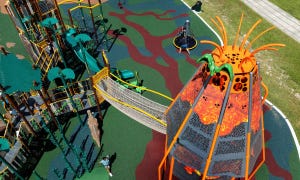Humans are designed to play throughout our lifetime, and communities are looking for ways to create opportunities for people of all ages to realize the benefits of play together. The benefits of multigenerational play are well-documented. Customers frequently ask us how to create a play area that appeals to all ages.
Here are some tips on how to design a great multigenerational playground.
1. Get Everyone Involved
A successful multigenerational playground considers the needs of everyone in your community. For example, shade structures and seating areas create comfortable areas for parents and grandparents to rest while children are playing. But don't stop there. Find ways to engage parents and grandparents in play. Consider adding game tables, sport courts, picnic areas and other amenities to the surrounding area. The idea is to find ways to get everyone involved in play.
Multigenerational Playgrounds Benefit Everyone
Studies have shown when parents and children interact with one another in play, there are mutual physical, social and emotional benefits that are enhanced by the shared experience – more so than when parents or children play alone.
Adults who regularly engage in play with children realize dramatic psychological and health benefits such as reduced stress, improved mood, greater cognitive skills and enhanced relationships. Children who play with adults:
- Demonstrate greater creativity and higher levels of language and problem-solving skills
- Engage in more sophisticated types of play
- Realize optimal cognitive and social-emotional development

2. Add Unique Play Activities
Design the playground to include play equipment that encourages adults to engage in playful behavior with children. Products like Expression Swing® allow an adult to swing face-to-face and eye-to-eye with a child. Renowned play researcher, Dr. Stuart Brown, MD, tells us when a parent and child's eyes meet while playing in this way it creates opportunities for significant emotional bonding (also called attunement), and enhances the cognitive and decision-making centers of the brain in both the child and the adult.

Encourage Older Children to Play, Too
Challenge Course® by GameTime is a fun outdoor obstacle course option that combines a timed obstacle course and a mobile app to encourage friends and family members to compete against the clock or with one another. Children and adults are flocking to obstacle courses to challenge themselves and each other. In schools, PE teachers use the mobile app to help students track their progress over time, and to compare their school's progress with schools across the country.

3. Personalize the Space
Don’t try to find one playground, green space or trail that appeals to every age group. The key to a successful multigenerational play space is to combine age-appropriate play areas and programming that appeals to everyone. For example, your playground area may include separate play systems for children ages 2 to 5 and 5 to 12 to address the specific physical and developmental needs of these two age groups.
Freestanding play activities like musical instruments can be installed within the play area to encourage people of all ages to make music together. You may also include an adjacent fitness area for older teens (ages 13+) and adults, or a walking and jogging path around the perimeter of the recreation area.

Make a Play Space Everyone Will Enjoy
By taking the time to plan a multigenerational playground and recreation area that appeals to people of all ages, you can create a space that attracts more visitors, encourages people to be more active and enhances the quality of life for everyone in your community. To learn more about building a multigenerational play area, contact a GameTime representative in your neighborhood.
- Trails (27)
- Schools (193)
- Press Releases (109)
- Playground Funding (5)
- Play Science & Research (62)
- Parks & Recreation (363)
- Outdoor Fitness (138)
- National Demonstration Site (32)
- Landscape Architects (79)
- Inclusive Play (109)
- Daycare and Early Learning (62)
- Custom Play (38)
- College Campus (28)
- Churches (51)
- Challenge Course (30)
- Featured Projects (77)
- BluePrint for Play (18)
- Site and Shade (9)


